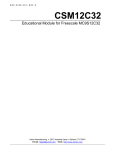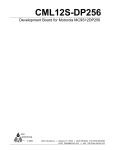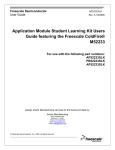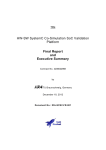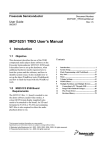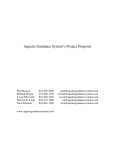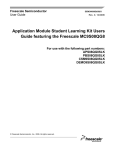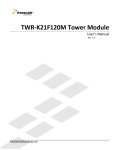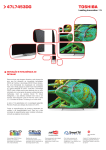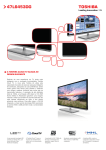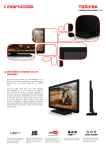Download Application Module Student Learning Kit Users Guide featuring the
Transcript
Freescale Semiconductor User Guide SLK0101UG Rev. 0, 9/2006 Application Module Student Learning Kit Users Guide featuring the Freescale MC9S12C32 For use with the following part numbers: CSM-12C32 APS12C32SLK PBS12C32SLK © Freescale Semiconductor, Inc., 2006. All rights reserved. _______________________________________________________________________ CONTENTS CAUTIONARY NOTES ..............................................................................................................4 FEATURES ................................................................................................................................5 REFERENCES ...........................................................................................................................6 INTRODUCTION ........................................................................................................................7 GETTING STARTED..................................................................................................................7 OPERATION ..............................................................................................................................7 POWER ................................................................................................................................. 8 PWR .................................................................................................................................. 8 CONNECTOR J1............................................................................................................... 8 PWR_SEL JUMPER.......................................................................................................... 8 RESET SWITCH ................................................................................................................... 9 LOW-VOLTAGE DETECT ..................................................................................................... 9 TIMING .................................................................................................................................. 9 COMMUNICATIONS ............................................................................................................. 9 COM CONNECTOR ........................................................................................................ 10 CONNECTOR J1............................................................................................................. 11 USER OPTIONS ................................................................................................................. 11 SWITCHES ..................................................................................................................... 11 LED’S............................................................................................................................... 12 DEVELOPMENT SUPPORT ....................................................................................................12 ASCII MONITOR OPERATION ........................................................................................... 12 ASCII MONITOR MEMORY MAP ................................................................................... 12 MONITOR COMMANDS ................................................................................................. 13 INTERRUPT SUPPORT.................................................................................................. 13 INTERRUPT VECTOR TABLE........................................................................................ 14 SERIAL MONITOR OPERATION........................................................................................ 15 SERIAL MONITOR MEMORY MAP ................................................................................ 15 BDM_PORT HEADER......................................................................................................... 16 2 Freescale Semiconductor FIGURES Figure 1: PWR_SEL ...................................................................................................................8 Figure 2: COM Connector.........................................................................................................10 Figure 3: MCU_PORT Connector .............................................................................................11 Figure 4: BDM_PORT...............................................................................................................16 TABLES Table 1: Serial COM Signals ....................................................................................................10 Table 2: User Option Jumper Settings......................................................................................11 Table 4: Monitor Commands ....................................................................................................13 Table 5: Monitor Memory Map..................................................................................................12 Table 6: MON12 Interrupt Vector Table....................................................................................14 Table 7: Serial Monitor Memory Map........................................................................................15 August 25, 2006 Freescale Semiconductor A REVISION Initial release 3 Cautionary Notes ♦ Electrostatic Discharge (ESD) prevention measures should be used when handling this product. ESD damage is not a warranty repair item. ♦ Axiom Manufacturing does not assume any liability arising out of the application or use of any product or circuit described herein; neither does it convey any license under patent rights or the rights of others. ♦ EMC Information on the APS12C32SLK module: a) This product as shipped from the factory with associated power supplies and cables, has been verified to meet with requirements of CE and the FCC as a CLASS B product. b) This product is designed and intended for use as a development platform for hardware or software in an educational or professional laboratory. c) In a domestic environment, this product may cause radio interference in which case the user may be required to take adequate prevention measures. d) Attaching additional wiring to this product or modifying the products operation from the factory default as shipped may effect its performance and cause interference with nearby electronic equipment. If such interference is detected, suitable mitigating measures should be taken. TERMINOLOGY This module uses option selection jumpers and cut-traces to setup default configuration. Terminology for application of the option jumpers is as follows: Jumper – a plastic shunt that connects 2 terminals electrically Jumper on, in, or installed - jumper is installed such that 2 pins are connected together Jumper off, out, or idle - jumper is installed on 1 pin only. It is recommended that jumpers be idled by installing on 1 pin so they will not be lost. Cut-Trace – a circuit trace connection between component pads. The circuit trace may be cut using a razor knife to break the default connection. To reconnect the circuit, simply install a suitably sized 0-ohm resistor or attach a wire across the pads. 4 Freescale Semiconductor FEATURES The APS12C32SLK is an educational application module for the Freescale Semiconductor MC9S12C32 microcontroller. Application module SLK’s include components for out-of-box operation and are preprogrammed with a serial monitor to make application development quick and easy. A background DEBUG port is provided for development tool use and is compatible with HCS12 BDM interface cables and software. The 40-pin connector allows the APS12C32SLK module to be connected to an expanded evaluation environment such as the Microcontroller Project Board Student Learning Kit (PBMCUSLK) or user’s custom PCB. Features: ♦ ♦ ♦ ♦ ♦ ♦ ♦ ♦ ♦ ♦ ♦ ♦ MC9S12C32 MCU, 48 QFP ♦ 32K Byte Flash EEPROM ♦ 2K Bytes RAM ♦ 31 I/O lines ♦ Timer/PWM ♦ SCI and SPI Communications Ports ♦ Key Wake-up Port ♦ BDM DEBUG Port ♦ CAN 2.0 Module ♦ Analog Comparator ♦ 8 MHz Internal Bus Operation Default ♦ 25 MHz Bus Operation using internal PLL ♦ +3.3VDC to +5VDC operation Power Input Selection Jumper On-board, regulated +5V power supply Optional power input/output from Connector J1 16 MHz Ceramic Resonator RS-232 Serial Port w/ DB9 Connector 8-Ch, 10-bit, Analog Comparator with full rail-to-rail operation and external trigger capability 8-Channel, 16-bit Timer with Input Capture, Output Compare, and PWM capabilities User Components Provided ♦ 3 Push Button Switches: 2 User, RESET ♦ 3 LED Indicators: 2 User, VDD Jumpers ♦ Disable User Components ♦ Power Select Connectors ♦ 40 pin connector provides access to most MCU I/O signals ♦ 2.0mm Barrel Connector Power Input ♦ DEBUG BDM Connector ♦ DB9 Communications Connector Supplied with DB9 Serial Cable, Documentation (CD), Manual, and Wall plug type power supply. Specifications: Module Size 2.2” x 1.6” Power Input: +9VDC @ 200 mA typical, +6 to +16VDC range Freescale Semiconductor 5 References Reference documents are provided on the support CD in Acrobat Reader format. information can be found in the Application Notes section of the Freescale Web site. APS12C32SLKSCHEM.pdf APS12C32SLKUG.pdf 9S12C32DGV1.pdf 9S12C32_ZIP.zip APS12C32SLKQSUG.pdf APS12C32SLKSW.zip AN2548.pdf More APS12C32SLK Application Module Schematic APS12C32SLK User Guide MC9S12C32 Device User Guide Zip file containing Device Block User Guides Quick Start Guide for use with stand-alone module CodeWarrior project for use with APS12C32SLK_QSUG Serial Monitor Program for HCS12 MCU’s The following reference documents are for using the application module in conjunction with the Freescale Microcontroller Project Board Student Learning Kit: PBS12C32SLKQSUG.pdf PBS12C32SLKSW.zip Quick Start Guide for application module use with PBMCUSLK CodeWarrior project for use with PBS12C32SLK_QSUG Visit www.freescale.com\universityprogram for current product information, reference materials and updates. 6 Freescale Semiconductor INTRODUCTION Before using this module, the user should be familiar with the hardware and software operation of the target MCU. Refer to the MC9S12C32 User Manual and MC9S12C32 Reference Manual for details on MCU operation. The module’s purpose is to promote the features of the MC9S12C32 and to assist the user in quickly developing an application in a known working environment. Users should be familiar with memory mapping, memory types, and embedded software design for quick, successful, application development. The APS12C32SLK Educational Module is a fully assembled, fully functional module supporting Freescale MC9S12C32 microcontroller. The module comes with a serial cable, power supply, and an embedded monitor for stand-alone operation. Support software for this module is provided for Windows 95/98/NT/2000/XP operating systems. Application development may be performed by using the embedded monitor, or any compatible BDM cable with supporting host software. The embedded monitor provides an effective, low cost, debug method. Note that when a BDM cable is used for debugging, the BDM pod should be powered from an external supply. GETTING STARTED Please refer to the APS12C32SLK Quick Start Users Guide to quickly setup the stand-alone application module or PBS12C32SLK Quick Start Users Guide to get started with the microcontroller project board (PBMCUSLK). Operation The APS12C32SLK module provides input and output features designed to assist embedded application development. Access to the MCU port signals is available through module connector J1. This connector may also be used to input power to the module or to output power to attached modules. RS-232 communications signals may also be input through connector J1. Care must be exercised when using the J1 to power the module, as only regulated voltage in the range of +3.3V to +5V should be supplied to this connection. The onboard regulator provides a fixed +5V voltage to the module. Five user option jumpers and 3 cut-traces control module operation. Enabling a user option requires installing a jumper across the associated header pins. Removing the jumper disables the associated option. An option enabled by a cut-trace can be disabled by removing the circuit trace between the cut-trace component pads. Use a sharp knife to cut the embedded circuit trace. Be careful not to damage adjacent circuitry. To re-enable the option, simply install a 1206 sized 0-ohm resistor or piece of wire across the cut-trace component pads. Freescale Semiconductor 7 Power Power is supplied to the module through a 2.0mm barrel connector at location PWR for standalone operation. The module may also be powered through connector J1 when connected to the PBMCUSLK. Power may be sourced off-module through connector J1 to external circuitry. Power routing on the module is determined by the PWR_SEL jumper. PWR The PWR connector accepts a 2.1mm, center-positive, barrel plug that allows the module to be powered from a wall-plug transformer or from a desktop power supply. Input voltage should be limited to between +7V and +20V. Input voltage of +9VDC is typical. This input supplies the on-board +5V regulator that powers the module. Connector J1 Power may be supplied to the module through the pins J1-1 and J1-2. Use of this option requires a regulated voltage input limited to the range of +3.3VDC to +5VDC. This input is connected directly to the module power and ground planes. Care should be exercised not to over-drive this input. Use of connector J1 to supply +3.3V to the module requires disabling the voltage supervisor (LV1) by opening cut-trace CT-1. See the Low-Voltage Detect section below. To re-enable the low-voltage supervisor, install a 1206 sized 0-ohm resistor at CT1. Connector J1 may also be used to source +5V power from the on-board regulator to external modules attached to connector J1. The PWR_SEL option header determines how power is routed to the module. PWR_SEL Jumper The PWR_SEL jumper is a 4-position option header that configures power routing on the APS12C32SLK module. The module may be powered by an external transformer connected to the PWR connector or through connector J1. The module may also source power to auxiliary modules connected to the connector J1. Damage may occur if the J1 power input pins are over-driven. Refer to the Figure 1 to determine correct PWR_SEL jumper setting. Figure 1: PWR_SEL 8 1 2 Source power input from barrel connector PWR. 1 2 Source power input from connector J1. 1 2 Source power from barrel connector PWR and supply power to external circuitry connected to J1. Freescale Semiconductor Reset Switch The RESET switch provides an asynchronous reset input to the MCU. Pressing the RESET switch produces a low-voltage level on the RESET input to the MCU. The low-voltage supervisor (LV1) holds the RESET line low for approximately 150 ms after the pushbutton is released. Low-Voltage Detect A DS1813 (LV1) provides POR, low-voltage detect, and pushbutton reset services for the module. At power-on, LV1 holds the MCU in reset for 150 ms after VCC reaches approximately 4.35V. During normal operation, LV1 asserts RESET when VCC falls below 4.35V and holds RESET true for 150 ms after VCC returns to normal. The push-button operation is described in the paragraph above. Use of connector J1 to supply +3.3V to the module requires disabling LV1. LV1 may be disabled by opening the cut-trace CT1. Simply remove the circuit trace between the cut-trace pads to open the circuit. To restore the circuit functionality, install a 1206 size, 0ohm, resistor or a short piece of wire across the cut-trace pads. Timing A ceramic resonator (Y1) provides a 16.0 MHz base operating frequency to the MCU. This supports a default 8.0 MHz internal operating frequency. Higher frequencies are possible using the embedded PLL. The resonator output is routed to the MCU only and is not available at the MCU Port connector (J1). The MCU ECLK output is available to the user at connector J1 if enabled. Communications The APS12C32SLK module provides a single RS-232 communications port. An RS-232 transceiver (U2) provides RS-232 signal level to TTL/CMOS logic level translation. RS232 signals TXD and RXD are routed between the transceiver and the MCU. These signals are also routed to connector J1. RS-232 communication signals input on J1 must be TTL/CMOS logic levels; no translation support is provided through this path. The transceiver output may also be driven off-module if the signals are suitably buffered. As added development support, hardware flow control signals RTS and CTS are available on the logic side of U2. These signals are routed to vias located near the transceiver (U2). RTS has been biased properly to support 2-wire RS-232 communications. Freescale Semiconductor 9 Use of the J1 connector to input RS-232 signals requires disabling the on-board RS-232 transceiver. Otherwise, signal corruption may occur. Disabling the on-board transceiver is accomplished by opening cut-traces CT1, and CT2. Simply remove the circuit trace between the cut-trace pads to open the circuit. To restore the circuit functionality, install a 1206 size, 0ohm, resistor or a short piece of wire across the cut-trace pads. Table 1: Serial COM Signals COM Signal TXD RXD MCU Port PS1/TXD PS0/RXD Connector J1-5 J1-7 Disable CT5 CT4 COM Connector A standard 9-pin D- Sub connector provides external connections for the COM port. The COM port is configured as a DCE device. Component U2 provides RS-232 translation services. The figure below shows the DB9 connector. Figure 2: COM Connector 7 RTS Female DB9 connector that interfaces to the DCE serial port via an RS232 transceiver. It provides simple 2-wire asynchronous serial communications without flow control. A straight-through serial cable may be connected to a DTE device such a PC 8 CTS Pins 1, 4, and 6 are connected together. 9 NC 1 6 TXD 2 RXD 3 4 GND 10 5 Freescale Semiconductor Connector J1 Connector J1 provides access to APS12C32SLK I/O port signals. Figure 3: MCU_PORT Connector Vx GND PS1/TXD PS0/RXD PP5/KWP5 PE0/XIRQ* PT0/PW0/IOC0 PT1/PW1/IOC1 PM4/MOSI PM2/MISO PM5/SCK PM3/SS* PE4/ELCK PE7/XCLKS PAD02/AN02 PAD03/AN03 PAD04/AN04 PAD05/AN05 PAD06/AN06 PAD07/AN07 1 3 5 7 9 11 13 15 17 19 21 23 25 27 29 31 33 35 37 39 2 4 6 8 10 12 14 16 18 20 22 24 26 28 30 32 34 36 38 40 PE1/IRQ* RESET* MODC/BKGD NC NC NC NC NC PAD00/AN00 PAD01/AN01 PB4 PA0 PM1/TXCAN PM0/RXCAN PT2/PW2/IOC2 PT3/PW3/IOC3 PT4/PW04/IOC4 PT5/IOC5 PT6/IOC6 PT7/IOC7 Default Signal Assignments MCU PORT Signal Disable PS1/TXD PS0/RXD PE1/IRQ* PP5/KWP5 PA0 PB4 COM1 TXD COM1 RXD SW1 SW2 LED1 LED2 CT-5 CT-4 User1 User2 User3 User4 Note: Default signal assignment should be disabled to use the signal at connector J1 User Options User options include 2 LED’s, and 2 pushbutton switches. Each user option may be enabled individually using the USER option header. When the appropriate USER option jumper is installed, the associated user option is enabled. Removing a jumper disables the associated user option. Table 2: User Option Jumper Settings Jumper User 1 User 2 User 3 User 4 On Enable SW1 Enable SW2 Enable LED1 Enable LED2 Off Disable SW1 Disable SW2 Disable LED1 Disable LED2 MCU Signal PE0/XIRQ* PP5 /KWP5 PA0 PB4 Switches Two push button switches provide momentary, active low, input to the MCU for user applications. Pressing a switch provides a momentary low logic level input tot the MCU. SW1 and SW2 provide input to MCUI/O ports PE0 and PP5 respectively. Freescale Semiconductor 11 LED’s Two LED’s provide active-low, visual output for user applications. A low voltage level driven out on the appropriate MCU port causes the LED to light. MCU ports PA0 and PB4 drive LED1 and LED2 respectively. Development Support The APS12C32SLK ships from the factory with a serial monitor installed in FLASH. An ASCII monitor is also installed to provide quick and easy debug access to the user. The text monitor is available out of RESET. The serial monitor is available by pressing and holding SW1 as the module exits RESET. In the discussion below, the terms text and ASCII are used interchangeably. ASCII Monitor Operation The debug monitor provides a simple application development platform for developing application code. The debug monitor allows the user to quickly and easily develop and debug RAM based application code. The debug monitor is accessible through the COM port using an ASCII terminal program such as HyperTerminal or AxIDE. The terminal should be configured for 9600, 8, N, 1 with no flowcontrol. The monitor relocates the hardware interrupt vector table from 0xFF8A:0xFFFF to 0X0F8A:0x0FFF(see Table 3 below). The vectors remain in the same order as the default hardware table. The Reset vector is reserved; user should use autostart to start applications from reset. ASCII Monitor Memory Map Table 3: Monitor Memory Map $0000 $03FF $0800 $0DFF $0E00 $0F8B $0F8A $0FFF $8000 $BFFF $C000 $FFFF 12 Registers 1K bytes Reserved Internal RAM. 1.5K bytes Monitor Reserved Relocated Interrupt Vector Table 512 bytes Reserved User Program Memory 16K bytes Protected Monitor Space 16K bytes Freescale Semiconductor Monitor Commands Table 4: Monitor Commands BF <StartAddress> <EndAddress> [<data>] BR [<Address>] CALL [<Address>] GO [<Address>] HELP LOAD [P] MD <StartAddress> [<EndAddress>] MM <Address> MW <Address> MOVE <StartAddress> <EndAddress> <DestAddress> RD OFFSET – [arg] Proceed RM STOPAT <Address> T [<count>] Block Fill memory range with data Set/Display user breakpoints Call user subroutine at <Address> Begin/continue execution of user code Display the Mon12 command summary Load S-Records into memory, P = Paged S2 Memory Display Bytes Modify Memory Bytes (8 bit values) Modify memory Words (16 bit values) Move a block of memory Display all CPU registers Offset for download Continue program execution Modify CPU Register Contents Trace until address Trace <count> instructions NOTE: Items in Italics are not implemented at this time. Interrupt Support All interrupt services under are provided through the relocated vector table, see Table 5 below. Each location in the table is initialized to a value of $0000 to cause the trap of an unscheduled interrupt. Any nonzero value will allow the interrupt to proceed to the user's service routine that should be located at the address indicated. The interrupt service delay is +21 cycles over the standard interrupt service. To use vectors specified in the table, the user must insert the address of the interrupt service routine during software initialization into the ram interrupt table. For an example, for the IRQ vector, the following is performed: Example: IRQ Service routine label = IRQ_SRV Ram Vector Table address is defined in table below, IRQ vector definition: VIRQ EQU $0FF2 ; define ram table vector location Place IRQ service routine address in the table: MOVW #IRQ_SRV,VIRQ This vector initialization will remain in effect until a RESET is invoked. Freescale Semiconductor 13 Interrupt Vector Table Table 5: MON12 Interrupt Vector Table Ram Interrupt Vector Address 0F8A 0F8C 0F8E 0F90 0F92 0F94 0F96 0F98 0F9A 0F9C 0F9E 0FA0 0FA2 0FA4 0FA6 0FA8 0FAA 0FAC 0FAE 0FB0 0FB2 0FB4 0FB6 0FB8 0FBA 0FBC 0FBE 0FC0 0FC2 0FC4 0FC6 0FC8 0FCA 0FCC 0FCE 0FD0 0FD2 0FD4 0FD6 0FD8 0FDA 0FDC 0FDE 0FE0 0FE2 14 MCU Interrupt Vector Address FF8A FF8C FF8E FF90 FF92 FF94 FF96 FF98 FF9A FF9C FF9E FFA0 FFA2 FFA4 FFA6 FFA8 FFAA FFAC FFAE FFB0 FFB2 FFB4 FFB6 FFB8 FFBA FFBC FFBE FFC0 FFC2 FFC4 FFC6 FFC8 FFCA FFCC FFCE FFD0 FFD2 FFD4 FFD6 FFD8 FFDA FFDC FFDE FFE0 FFE2 TRAP code 02 04 06 08 0A 0C 0E 10 12 14 16 18 1A 1C 1E 20 22 24 26 28 2A 2C 2E 30 32 34 36 38 3A 3C 3E 40 42 44 46 48 4A 4C 4E 50 52 54 56 58 5A Vector Source LVI PWME PTPI C4TX C4RX C4ERR C4WU C3TX C3RX C3ERR C3WU C2TX C2RX C2ERR C2WU C1TX C1RX C1ERR C1WU C0TX C0RX C0ERR C0WU FEPRG EEPRG SPI2 SPI1 I2C BDLC CRGC CRGL PACBO MCNT PTHI PTJI ADC1 ADC0 SCI1 SCI0 SPI0 PACAI PACAO TOF TC7 TC6 Freescale Semiconductor Ram Interrupt Vector Address 0FE6 0FE8 0FEA 0FEC 0FEE 0FF0 0FF2 0FF4 0FF6 0FF8 0FFA 0FFC 0FFE MCU Interrupt Vector Address FFE6 FFE8 FFEA FFEC FFEE FFF0 FFF2 FFF4 FFF6 FFF8 FFFA FFFC FFFE TRAP code 5E 60 62 64 66 68 6A 6C 6E 70 72 74 76 Vector Source TC4 TC3 TC2 TC1 TC0 RTI IRQ XIRQ SWI TRAP COP CLM RESERVED Serial Monitor Operation A serial binary monitor is loaded in the MCU internal flash memory. Press and hold SW1 while pressing the RESET button or applying power. This section provides a brief description of this serial monitor operation. Refer to application note AN2548 for complete details on the serial monitor operation. This application note may be found on the Support CD received with the module or from the Freescale web site. Serial Monitor Memory Map Table 6: Serial Monitor Memory Map 0x0000 – 0x03FF 0x3800 – 0x3FFF 0x8000 – 0xBFFF 0xC000 – 0xF77F 0xF780 – 0xF7FF 0xF800 – 0xFFFF Registers 1K bytes Reserved Internal RAM (Relocated) Reserved 2K bytes Fixed Flash EEPROM Block 1 (visible at RESET) Fixed Flash EEPROM Block 2 User Vectors (Relocated) User Reset Vector F7FE:F7FF Vectors (Protected) 16K bytes 13.8K bytes 2.12K bytes NOTE: Although the monitor does not support external memory, the user can enable external memory accesses in the unfilled areas of the memory map. The 2K-byte serial monitor program provides an RS-232 serial interface to a host PC. Serial data rate is 115.2K bps. The monitor is compatible with Metrowerks CodeWarrior Freescale Semiconductor 15 Development Studio and other serial monitor interface IDE’s. The serial monitor is not compatible with ASCII interface programs such as HyperTerm or AxIDE. The monitor supports 23 primitive commands to control the target MCU. To allow a user to specify the address of each interrupt service routine, this monitor redirects interrupt vectors to an unprotected portion of FLASH. To boot to the serial monitor, the user simply pressed and holds SW1 while pressing the RESET switch or applying power. The status of SW1 is read only during the rising edge of RESET. To load user application on start-up, the user is responsible for programming the pseudo-reset vector (0xF7FE:0xF7FF). Pressing SW1 after the MCU exits reset will not access the serial monitor. After exiting reset, pressing SW1 has effect as defined in the user application. BDM_PORT Header BDM access is gained through the BDM_PORT header. This is a 6-pin header that allows connection of a compatible HCS12 BDM cable. Refer to the documentation for the specific BDM cable used for details on its use. The figure below shows the pin-out for the DEBUG header. Figure 4: BDM_PORT MODC/BKGD 16 1 3 5 2 4 6 GND RESET* VDD See the HC12 Reference Manual for complete DEBUG documentation Freescale Semiconductor How to Reach Us: Home Page: www.freescale.com E-mail: [email protected] USA/Europe or Locations Not Listed: Freescale Semiconductor Technical Information Center, CH370 1300 N. Alma School Road Chandler, Arizona 85224 +1-800-521-6274 or +1-480-768-2130 [email protected] Europe, Middle East, and Africa: Freescale Halbleiter Deutschland GmbH Technical Information Center Schatzbogen 7 81829 Muenchen, Germany +44 1296 380 456 (English) +46 8 52200080 (English) +49 89 92103 559 (German) +33 1 69 35 48 48 (French) [email protected] Japan: Freescale Semiconductor Japan Ltd. Headquarters ARCO Tower 15F 1-8-1, Shimo-Meguro, Meguro-ku, Tokyo 153-0064, Japan 0120 191014 or +81 3 5437 9125 [email protected] Asia/Pacific: Freescale Semiconductor Hong Kong Ltd. Technical Information Center 2 Dai King Street Tai Po Industrial Estate Tai Po, N.T., Hong Kong +800 2666 8080 [email protected] For Literature Requests Only: Freescale Semiconductor Literature Distribution Center P.O. Box 5405 Denver, Colorado 80217 1-800-441-2447 or 303-675-2140 Fax: 303-675-2150 [email protected] Design and/or Manufacturing services for this product provided by: Axiom Manufacturing 2813 Industrial Lane Garland, Tx. 75041 Phone: 972-926-9303 Web: www.axman.com Email: [email protected] SLK0101UG Rev. 0 09/2006 Information in this document is provided solely to enable system and software implementers to use Freescale Semiconductor products. There are no express or implied copyright licenses granted hereunder to design or fabricate any integrated circuits or integrated circuits based on the information in this document. Freescale Semiconductor reserves the right to make changes without further notice to any products herein. Freescale Semiconductor makes no warranty, representation or guarantee regarding the suitability of its products for any particular purpose, nor does Freescale Semiconductor assume any liability arising out of the application or use of any product or circuit, and specifically disclaims any and all liability, including without limitation consequential or incidental damages. “Typical” parameters that may be provided in Freescale Semiconductor data sheets and/or specifications can and do vary in different applications and actual performance may vary over time. All operating parameters, including “Typicals”, must be validated for each customer application by customer’s technical experts. Freescale Semiconductor does not convey any license under its patent rights nor the rights of others. Freescale Semiconductor products are not designed, intended, or authorized for use as components in systems intended for surgical implant into the body, or other applications intended to support or sustain life, or for any other application in which the failure of the Freescale Semiconductor product could create a situation where personal injury or death may occur. Should Buyer purchase or use Freescale Semiconductor products for any such unintended or unauthorized application, Buyer shall indemnify and hold Freescale Semiconductor and its officers, employees, subsidiaries, affiliates, and distributors harmless against all claims, costs, damages, and expenses, and reasonable attorney fees arising out of, directly or indirectly, any claim of personal injury or death associated with such unintended or unauthorized use, even if such claim alleges that Freescale Semiconductor was negligent regarding the design or manufacture of the part. Freescale™ and the Freescale logo are trademarks of Freescale Semiconductor, Inc. All other product or service names are the property of their respective owners. © Freescale Semiconductor, Inc. 2006. All rights reserved.

















